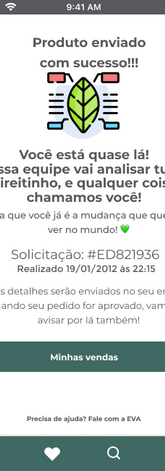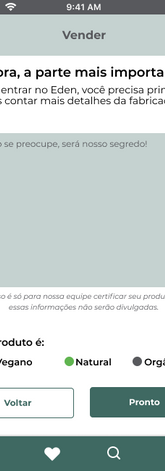
Eden
Meet Eden, your new marketplace app for sustainable products. And, if you have any doubt, consult EVA - Eden Virtual Assistant.
Problem
Climate chages
During the United Nations Summit on Sustainable Development in 2015, the Sustainable Development Goals (SDGs) emerged as part of a broader project, the 2030 Agenda.
Together, the UN SDGs outline a universal plan to achieve a better future and one of them is SDG 13, which deals with Action Against Global Climate Change, which one of the goals is to mobilize 100 billion dollars a year to help developing countries in their actions to mitigate climate-related disasters. SDG 13 is strategic and serves to mobilize actors capable of promoting the necessary actions to combat climate change.
Research
Understanding the problem
Climate change is long-term changes in temperature and climate patterns. These changes can be natural, such as through variations in the solar cycle. But since 1800, human activities have been the main driver of climate change, mainly due to the burning of fossil fuels like coal, oil and gas.
Many people think that climate change mainly means higher temperatures. But the rise in temperature is just the beginning of the story.
As the Earth is a system, where everything is connected, changes in one area can influence changes in all others. The consequences of climate change now include, but are not limited to, severe droughts, water shortages, severe fires, rising seas, floods, melting polar ice, catastrophic storms, and declining biodiversity.
In short, climate change is a global problem whose impacts affect economies and people everywhere, especially the most vulnerable populations in developing countries. According to a report published in October 2018 by the Intergovernmental Panel on Climate Change (IPCC), an agency linked to the UN, without immediate action, the earth's temperature could increase by 3ºC by the end of the 21st century.
For Brazil to comply with the 2030 Agenda, the rate of gas emissions must decrease by 37% by 2025.
Definition
Focus problem
Through the research carried out, several problems related to climate change were identified, and to define the focus problem, it was necessary to carry out quantitative research to understand how people deal with the subject of sustainability. Based on the responses collected, the following data follows:
-
48% — Believe that people are responsible for climate change.
-
38.5% — Believe that the lack of information is an impediment to carrying out sustainable actions.
-
75% — Don't have sustainable habits.
Therefore, in order to help define the problem, the CSD matrix (certainties, suppositions and doubts) was used to direct the studies through qualitative research, in which, through interviews with different profiles, we were able to confirm the following hypotheses:
-
Lack of government incentives regarding sustainability
-
Lack of initiative and information for material reuse
-
People find it difficult to sell and buy products with a long life cycle that are truly trustworthy.
We talked to organic producers, environmentalists, biologists and activists. And we developed personas with different perspectives on the topic.
Pain points
After the interviews and personas, we identified very latent pain points, among them we have:
-
Price — Producers reported difficulty in pricing their products competitively and fairly, which directly impacts the consumer's choice decision.
-
Origin — Consumers expressed difficulty in comparing products and services in the market, increasing the difficulty in validating the origin, if in fact what is being advertised had less environmental impact.
-
Distribution — Difficulty in shipping products due to low demand and freight costs.
-
Research — Both in the comparison of manufacturing inputs and in the market, the pain of carrying out research and having a grouped variety proved to be very latent.
User journey
With the difficulties mapped, it was possible to survey the journey of the personas Marcelo and Thais, this mapping was essential to discover and help in decision making.

Ideation
User problem
The first step to prioritize ideas was to use How Might We, whose principle objective is to raise more closed questions according to our mapped problems, the chosen questions are applied in the user journey stages in which it makes the most sense.
The questions raised were:
-
How could we generate value from sustainable actions by scoring companies and people for their actions?
-
How could we easily give ourselves more access to sustainability information?
-
How could we educate by generating points after actions that contribute to sustainability?
-
How could we increase the profit vision of sustainable products?

After all the generation of ideas, we arrived at the definition point to idealize the solutions.




















